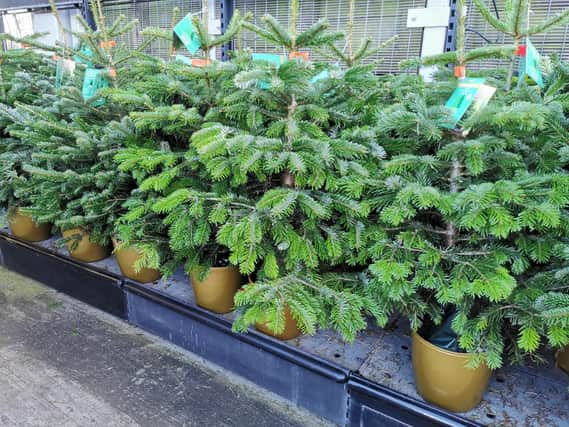Spruce up your tree to discourage needle loss


Most of them are cut, and in this respect they’re no different to the flowers we see for sale at the market stalls in that they are grown as a commercial crop. However, unlike the blooms mentioned, tree cultivation obviously takes much more than a single growing season.
For a two-metres tall Nordmann fir (Abies nordmanniana), we’re talking ten years from seed to selling. This time-consuming journey to maturity plus a reputation for holding on to its needles are reflected in the price. Alternatives, also with good needle-holding capacity, include the Fraser fir (Abies fraseri), Korean fir (Abies koreana), Noble fir (Abies procera) and Douglas fir (Pseudotsuga menziesii).
Advertisement
Hide AdAdvertisement
Hide AdThe Norway spruce (Picea abies), Serbian spruce (Picea omorica) and blue spruce (Picea pungens) are generally less expensive because they are quicker to mature and do have a reputation for losing needles when stressed.
This is not to say that a Nordmann retains every single one of its modified leaves during the weeks it spends in the central heating of a home. My experience is of modest needle-loss despite adequate watering. In keeping with a flower stem that’s just been removed from the parent plant, dehydration and shrinkage begins the day it is felled. However, the needles do have a superior structural mechanism in their attachment to branches. This is an advantage when you consider there are circa 20,000 of them on a two-metre tree. So how can we keep them all on board?
Treat all cut trees whatever their needle-holding capacity or reputation, as you would a flower stem. When you get it home take a saw and remove the bottom three centimetres of its trunk to expose active cells.
Plunge it into a bucketful of water and let it stand in the garage for a day or two. This encourages the tree to restart the process of translocating water throughout the system.
Advertisement
Hide AdAdvertisement
Hide AdHelpfully, sales outlets generally have weighted clamps with a built-in reservoir for sale. Transfer your tree to one of these and most importantly, keep the water level topped up. In a warm room, one litre of water per day can be processed via transpiration and evaporation.
Respect the tree and nature by ensuring it’s recycled after the celebrations.
CONIFERS ARE NOT JUST FOR CHRISTMAS
I’ve noticed a great increase in the number of living Christmas trees on sale recently.
Some are growing in pots while others have the roots covered in plastic, allowing the buyer a say in the container type they’ll occupy.
Advertisement
Hide AdAdvertisement
Hide AdThe idea is to transfer them outdoors and keep them growing after Christmas. So, their few weeks in the house should be without stress.
Best position for them is a cool, well-lit room with watering carefully monitored.
While the tree enjoys pride of place over the yuletide period give some thought to where it will be transplanted in the garden afterwards to continue growth.
Not too close to the house I’d advise, bearing in mind the height conifers can reach at maturity.
Advertisement
Hide AdAdvertisement
Hide AdIf the intention is to bring it indoors for future Christmas celebrations the roots must be constrained, which means leaving it in the pot when you plant in the garden.
Be sure to plunge it below soil level, feed occasionally, and offer water throughout summer.
For the ultimate in satisfaction, buy seeds of a favourite conifer or, collect some fallen cones and observe as they open to reveal seeds in a warm environment.
Put drainage pebbles in the bottom of a clay pot and cover it with a layer of larch needles or similar natural material.
Advertisement
Hide AdAdvertisement
Hide AdAdd compost until the pot is three-quarters full, sow the seeds thinly and cover with two centimetres of horticultural grit. Stand the pot outside, and let nature do the rest.
We are currently encouraged to plant a tree as a contribution toward a greener environment so there is good reason to go for one with roots and embrace the challenge of nurturing it well beyond Christmas 2021!